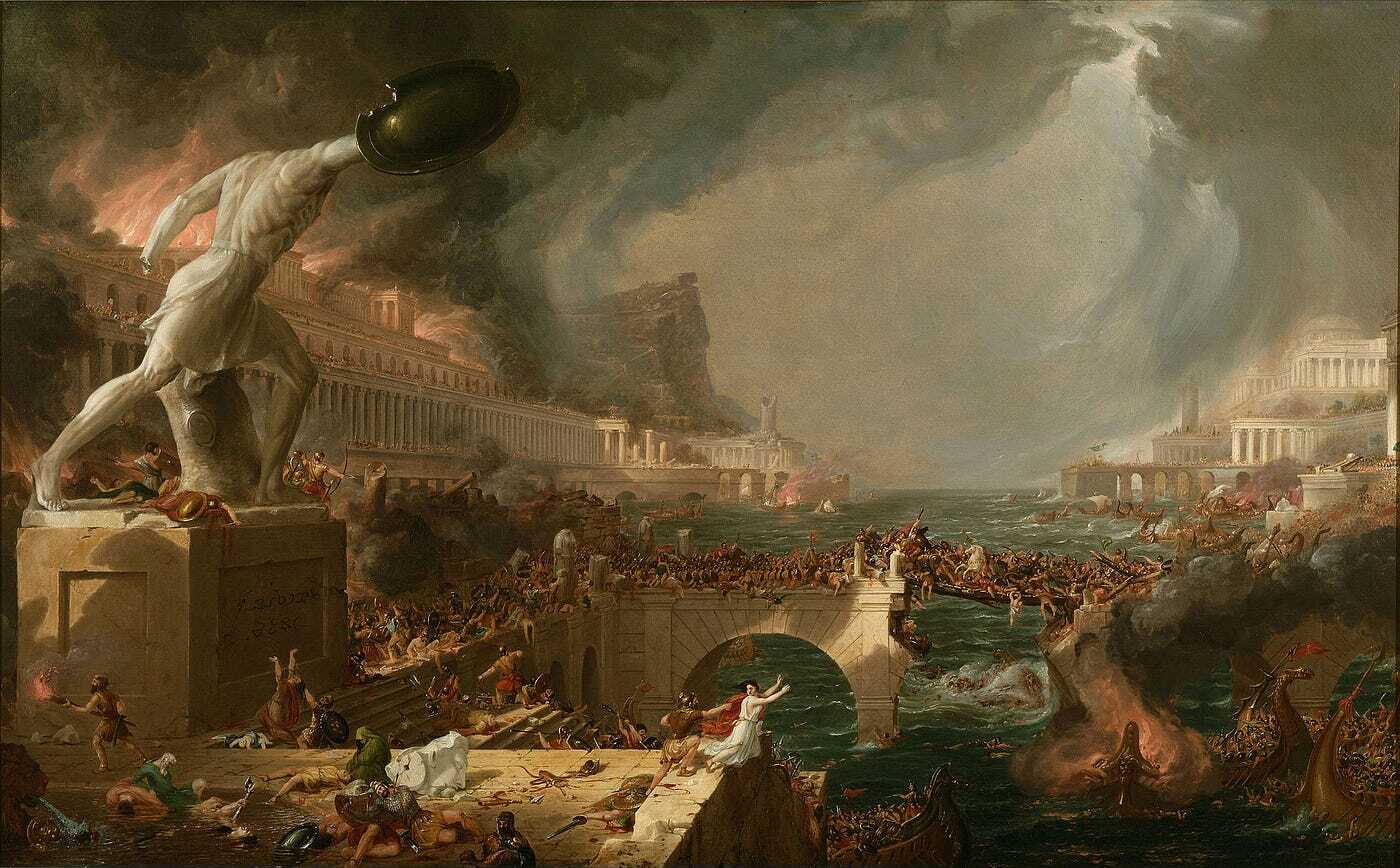
What caused the Late Bronze Age Collapse? The Late Bronze Age Collapse, occurring between 1200 and 1100 BCE, remains one of history's most intriguing mysteries. This period saw the sudden and violent downfall of major civilizations across the Eastern Mediterranean and Near East. Theories abound, ranging from natural disasters like volcanic eruptions and droughts to invasions by the enigmatic Sea Peoples. Some scholars point to systemic failures in trade networks and palace economies, while others suggest internal rebellions and disease played crucial roles. Understanding this collapse involves piecing together archaeological evidence, historical records, and climate data to reveal a complex web of interconnected factors.
Key Takeaways:
- The Late Bronze Age collapse was a sudden and violent event that led to the downfall of major civilizations in the Eastern Mediterranean and Near East, caused by a complex interplay of factors including natural disasters, invasions, and internal pressures.
- The collapse had long-lasting effects, leading to significant changes in the region and marking the transition to the Iron Age. It serves as a valuable lesson for managing global systems and mitigating potential crises in the present day.
What Was the Late Bronze Age Collapse?
The Late Bronze Age collapse was a significant event in human history, occurring between 1200 and 1100 BCE. This period saw the downfall of several major civilizations in the Eastern Mediterranean and Near East. Let's dive into the key facts that define this era.
-
Definition and Timeline: The Late Bronze Age collapse refers to the decline and fall of major Mediterranean civilizations during the 13th-12th centuries BCE.
-
Geographical Scope: The collapse affected a large area of the Eastern Mediterranean, including North Africa, Southeast Europe, and the Near East. Specifically, it impacted Egypt, eastern Libya, the Balkans, the Aegean, Anatolia, and to a lesser degree, the Caucasus.
-
Sudden and Violent: The collapse was sudden and violent, causing significant cultural disruption and economic decline among regional powers.
The Impact on Civilizations
The collapse didn't just affect one or two regions; it had widespread consequences for many powerful civilizations of the time.
-
Palace Economy Disintegration: The palace economy of Mycenaean Greece, the Aegean region, and Anatolia disintegrated, transforming into small isolated village cultures of the Greek Dark Ages.
-
Hittite Empire Collapse: The Hittite Empire of Anatolia collapsed, while states like the Middle Assyrian Empire in Mesopotamia and the New Kingdom of Egypt survived in weakened forms.
-
Phoenician Autonomy: Other cultures like the Phoenicians enjoyed increased autonomy and power with the waning military presence of Egypt and Assyria in West Asia.
Theories Behind the Collapse
Many theories have been proposed to explain why such a widespread collapse occurred. Here are some of the most compelling ones.
-
Competing Theories: Various theories have been proposed to explain the collapse, including volcanic eruptions, droughts, disease, invasions by the Sea Peoples or migrations of the Dorians, economic disruptions due to increased ironworking, and changes in military technology and strategy.
-
Volcanic Eruptions: Some scholars suggest that volcanic eruptions, such as the Hekla 3 eruption in Iceland, could have caused famines and a volcanic winter, contributing to the collapse.
-
Droughts: There is evidence of severe droughts in the region, which would have caused crop failures and famine. This is supported by archaeological findings and historical records.
-
Disease: Recent evidence suggests that the collapse of cultures in Mycenaean Greece, Hittite Anatolia, and the Levant may have been precipitated or worsened by the arrival of an early and now-extinct strain of the Bubonic Plague.
The Role of the Sea Peoples
One of the most discussed groups in the context of the Late Bronze Age collapse is the Sea Peoples. Their invasions had a significant impact on the region.
-
Sea Peoples Invasions: The invasions by the Sea Peoples are widely attributed to the collapse, although this explanation is considered simplistic. The Sea Peoples were a group of naval raiders who attacked coastal cities and towns.
-
Archaeological Evidence: Archaeological findings, such as letters from the king of Ugarit to the king of Alashiya, report sea raids and migrations, providing textual evidence for the invasions.
Systemic Collapse and Natural Disasters
The collapse wasn't just due to human actions; natural disasters played a crucial role as well.
-
Systemic Collapse: The integrated system of international trade networks and advanced diplomatic and legal systems established between imperial powers was severely disrupted, leading to a systemic collapse.
-
Natural Disasters: Natural disasters, including earthquakes and droughts, contributed to the decline of the Bronze Age civilizations. These disasters weakened the structures of the empires, making them more vulnerable to external threats.
-
Trade Interruptions: The disruption of trade relations and systems collapse played a significant role in the collapse. Trade was essential for the survival of these civilizations, and its interruption led to economic failures.
Internal Pressures and Climate Change
Internal dynamics and environmental factors also contributed to the collapse, making it a multifaceted event.
-
Internal Pressures: Internal pressures and dynamics weakened various civilizations, leaving them prone to external threats such as climate changes and foreign invasions.
-
Climate Change: Climate change is considered a pivotal factor in the collapse. Archaeologists have presented strong scientific evidence that the climate of the entire region became warmer and more arid, leading to crop failures and socio-economic crises.
-
Mega-Drought: A mega-drought struck the region between 1200-850 BCE, evidenced through pollen and alluvial records. This drought had a significant impact on harvests and led to famine, which in turn drove migration and invasion.
-
Declining Precipitation: Declining precipitation led to drought, which affected harvests and resulted in famine. This famine would have driven migration and invasion, contributing to the collapse.
-
Westerly Winds: A decline in Mediterranean Sea surface temperatures before 1190 BCE decreased annual freshwater flux by lowering evaporation rates. Westerly winds took in less water vapor, resulting in declining precipitation.
Records and Evidence
Historical records and archaeological evidence provide a clearer picture of what happened during this tumultuous period.
-
Egyptian Records: Egyptian records indicate that drought had undermined grain stores and social stability. The New Kingdom of Egypt survived the invasion of the Sea Peoples but was badly weakened in the process.
-
Hittite Records: Hittite records also indicate that drought had a significant impact on their empire. The Hittite Empire never recovered from the collapse.
-
Assyrian Survival: The Assyrian state survived the collapse but lost its territories in the south to Elam, a warlike kingdom based in present-day southern Iran.
-
Foreign Invaders: The identity of the foreign invaders is not clear from the scant surviving record. However, it is possible that the “bandits” blamed for destabilizing the region might have been a combination of foreign invaders and peasants displaced by drought and social chaos.
-
Peasant Rebellion: Peasant rebellion could have played a role in the collapse, as displaced peasants might have joined invasions out of desperation.
Long-Term Consequences
The aftermath of the collapse had long-lasting effects on the civilizations involved, leading to significant changes in the region.
-
Decades of Invasions: The invasions took place over the course of decades, from roughly 1180 to 1130 BCE, and must have played a major role in the collapse of the Bronze Age political and economic system.
-
Trade Network Disruption: The networks of trade and diplomacy established during the Bronze Age were either disrupted or destroyed completely. This disruption had a profound impact on the economies of the affected regions.
-
Greek Dark Ages: The collapse led to a Greek “dark age” that lasted for three centuries. During this period, Mycenaean civilization collapsed utterly, and there was a significant decline in art, architecture, and general quality of life.
Transition to the Iron Age
The collapse marked the end of one era and the beginning of another, with significant technological and societal changes.
-
Iron Age Transition: The collapse marked the transition to the Iron Age, during which iron replaced bronze as the metal of choice. This transition was gradual but significant, leading to changes in metallurgic technology and societal structures.
-
Technological Advancements: The spread of ironworking technology from present-day Bulgaria and Romania in the 13th and 12th centuries BC allowed for larger armies equipped with iron weapons to overwhelm smaller bronze-equipped armies.
-
Leonard R. Palmer’s Theory: Leonard R. Palmer suggested that iron, being superior to bronze for weapons manufacturing, was in more plentiful supply and thus allowed larger armies to overwhelm smaller ones.
Migration and Systemic Reversals
Large-scale migrations and systemic changes were also significant factors in the collapse.
-
Migratory Invasions: The era was marked by large-scale migration of people at the end of the Late Bronze Age. Drought in the Nile Valley may have contributed to the rise of the Sea Peoples and their sudden migration across the eastern Mediterranean.
-
Systemic Reversals: A general systems collapse has been put forward as an explanation for the reversals in culture that occurred between the Urnfield culture of the 13th and 12th centuries BC and the rise of the Celtic Hallstatt culture in the 9th and 10th centuries BC.
Scholarly Perspectives
Various scholars have contributed to our understanding of the Late Bronze Age collapse, each offering unique insights.
-
Historical Records: Historical records from the time, such as letters from the king of Ugarit, provide evidence of sea raids and migrations. These records help historians understand the scale and impact of the invasions.
-
Scholarly Consensus: The consensus among scholars is that the collapse was not caused by a single factor but rather a complex interplay of factors, including natural disasters, internal pressures, and external invasions.
-
Chris Harman’s Argument: Chris Harman argues that internal pressures and dynamics weakened various civilizations, leaving them prone to external threats such as climate changes and foreign invasions. He takes a broader view, arguing that the Bronze Age Collapse is part of a larger trend he terms “crises of early civilization”.
-
Vere Gordon Childe’s Influence: Harman’s argument is heavily indebted to Vere Gordon Childe, who also discussed the systemic collapse of early civilizations.
The Sea Peoples and Archaeological Evidence
The term "Sea Peoples" has become synonymous with the invasions that marked the end of the Bronze Age.
-
French Egyptologist Gaston Maspero: Gaston Maspero first coined the term “Sea Peoples” in reference to the invading forces of the 13th and 12th centuries BCE in 1881. This term has since been widely used to describe the groups responsible for the invasions.
-
Archaeological Evidence from Soreq Cave: The Soreq cave in Israel contains a 150,000-year record of precipitation for the northern Levant, showing an unprecedented and steady decline in rainfall ongoing through 1150 BCE. This evidence supports the theory that climate change played a significant role in the collapse.
-
Lessons for the Present Day: The lessons of the Bronze Age Collapse are particularly pertinent today, as the globally-linked world closely resembles the intricate network of nations that characterized this era. Understanding the complex interplay of factors leading to the collapse can provide valuable insights into managing global systems and mitigating potential crises.
Lessons from the Late Bronze Age Collapse
The Late Bronze Age collapse was a whirlwind of chaos, marked by the fall of mighty civilizations like the Hittites and Mycenaeans. This period, spanning roughly from 1200 to 1100 BCE, saw a mix of natural disasters, climate change, and invasions by the Sea Peoples. These factors combined to disrupt trade networks and palace economies, leading to widespread societal breakdowns. The mega-drought and declining precipitation played a significant role, causing crop failures and famine. The collapse wasn't just about external pressures; internal dynamics and technological shifts, like the rise of ironworking, also contributed. Understanding this complex event helps us appreciate the resilience and fragility of civilizations. It serves as a reminder that interconnected systems can be both a strength and a vulnerability. The lessons from this ancient collapse are still relevant today, offering insights into managing modern global challenges.
Frequently Asked Questions
Was this page helpful?
Our commitment to delivering trustworthy and engaging content is at the heart of what we do. Each fact on our site is contributed by real users like you, bringing a wealth of diverse insights and information. To ensure the highest standards of accuracy and reliability, our dedicated editors meticulously review each submission. This process guarantees that the facts we share are not only fascinating but also credible. Trust in our commitment to quality and authenticity as you explore and learn with us.


